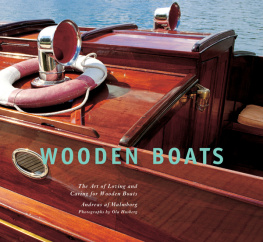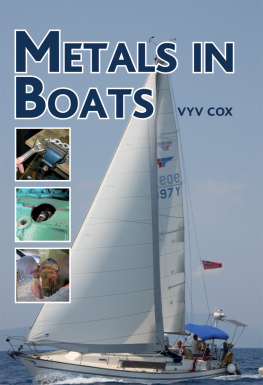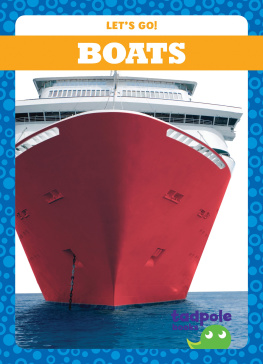We wanted to write a book about wooden boats because we both grew up with wooden boats and feel we have some insight into their special qualities. When youve slept under the foredeck and listened to the water lapping against the planking when youve heard the rigging creaking and felt the scent of varnish and paint when youve swung open the cabin doors to be struck by a clear July morning filled with summer-dry mahogany and a hint of gasoline when youve spent a January evening under a cover whistling to yourself with a can of linseed oil in your hand when the temperature is only 10F outside and your breath rises in a plume then youve felt something of the uniqueness of wooden boats.
This book is about pleasure boats made from wood. Weve tried to describe what makes them beautiful, fun, enchanting, practical, and special. Wooden boats demand a lot of work from you but they also reward you in return. A well-cared-for wooden boat gives its owner pride, confidence, and a special status. The preparatory work routines, the feeling of togetherness, the imagination and creativity releasedits all part of the great wooden boat experience. No country has a greater wealth of unique wooden boats than Sweden. In the pages that follow, we present a few of them.
We extend our thanks to all the professionals and owners who have given us their time, knowledge, and commitment, in particular: Mats Arrhnborg, Bjrn Askerlund, Christian and Jeanette Barfod, Anna Blomberg, Kjell Blomberg, Maria Blomberg, Bengt Braun, Paul Brauns, Erik Brjesson, Thomas Orup Eriksson, Hans Himbert, Joakim Irebjer, Lennart Ivarsson, Anders Jelving, Harry Johans, Thomas Larsson, Christer Larsson, Johan Mnsson, Joakim Norrman, Solveig och Lars Nygren, Bitte Rask, Ulf Selberg, Tom Stocklassa, Pr Wahlgren, Hasse Wetterberg, Helena berg, Lars stervall.
Bergshamra and Liding, December 1998
Andreas af Malmborg and Ola Husberg
A small ship

Sela |
One-man yacht |  |
24 7
17 5
5 11
1.8 long tons
300 sq ft | length overall
length at the waterline
beam
displacement
sail area |
Every boat has a story to tell but those of wooden boats are often conspicuous. The same boat may have had several owners, been modified, repaired, rebuilt, or re-rigged. That is especially true of the clipper Sela who has had around twenty owners since she was built over a hundred years ago. When you see her sailing over Baggensfjrden bay in Stockholm, it only feels like a short step back to the last century and the time of the Swedish painters Bruno Liljefors and Anders Zorn. The boat even resembles Zorns boat Mejt . Mejt was twice as large as Sela but shared the same designer and was built at the Mlarvarv shipyard in Stockholm, 1893. Selas owner Joakim Norrman has put a lot of effort into researching the boats history. The search began in the archives of Stockholms Maritime museum. Locating the original drawings would have been an ideal start but the effort went in vain.

Sela in the midday breeze on Baggensfjrden bay outside Stockholm.
The first promising leads came via another path and led back to the 1950s. A previous owner had undertaken a thorough rebuild of the boat and had documented this work with photography. These pictures revealed how Selas cabin looked originally.
The Royal Librarys collections were scoured along with archives of sports newspapers, old magazines, annuals, anniversary books, and sailing society material. Pictures were useful in opening up new avenues of discovery, taking the search onward. The breakthrough came when a photograph showed up in the 50th anniversary book of the Vsters sailing society. The picture showed a clipper, suspiciously similar to Sela , and beneath the picture appeared the name of a local pharmacist.
The Parish church in Vsters identified the pharmacists family and, sure enough, it turned out to be the right boat. The pharmacist was no longer alive but his grandchildren who were now retired were able to help. Just by locating the name of this early owner name, the chain of ownership could be filled in both forwards and backwards through time. As the evidence was complemented with memories, log books, and pictures from family albums, the story of Selas life was gradually revealed.
She was so practical with all those cupboards in the cabin, explained one old lady over the telephone. And so it was confirmed, just as suspected, that the forecastle had previously been one huge cupboard with cupboard doors all along the inside of the planking. One old picture showed how it looked with all the details including the frames, trim, and cupboard door windows.

Sela has been renovated with great respect toward her original design and function.
Yet the original drawings were still missing. A second visit to the Maritime museum and another bundle of papers relating to the Mlarvarv shipyard finally yielded a clue. Amongst the papers were drawings of a one-man yacht designed by Albert Andersson, built at the Mlarvarv yard and sold for 1400 Swedish crowns ($200).

Now only the original sail plan is missing. It must be somewhere and so the search continues. Selas ownership history is, nevertheless, nearly complete now with just a small gap at the end of the 19th century.
Sela came about at a time when interest in sailing was widening but sailboats were still large, commercial vessels. Small pleasure boats did not exist and few could afford a large yacht with a full crew.
This was when the idea of a smaller yacht, easier to sail and look after, and cheaper to build, came about in the KSSS (the Royal Swedish Yacht Club). The dream was of a yacht that could be sailed solo but could also accommodate two a one-man yacht. The only demand was that the boat be small: the length at the waterline plus the beam may not extend beyond 21 feet. The challenge was keenly set upon. Imagination flowed and draughtsmen designed everything from canoe-style cruisers and experimental cabin boats to modern fin keel boats.
One of the results of this work was Sela . She is in principle a small ship, a miniature version of a 50-foot yacht. Her hull is deep, heavy, and robust, and the bow is sharp. She cuts through the water with dignity and obediently follows every murmur from the rudder. Even when there is barely any wind, shell sniff out a breeze and move steadily along her course. She is unusually heavy with good stability, both longitudinally and transversely, as she cautiously stamps through the waves. Tacking through narrow passes poses no problem. On a reach, she luffs up eagerly and you have to work with the tiller to keep her on course.

















